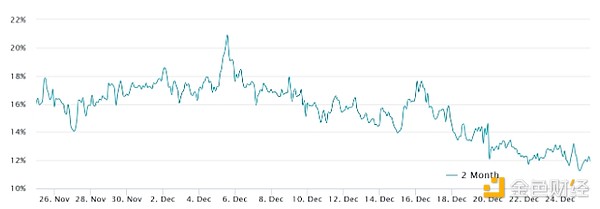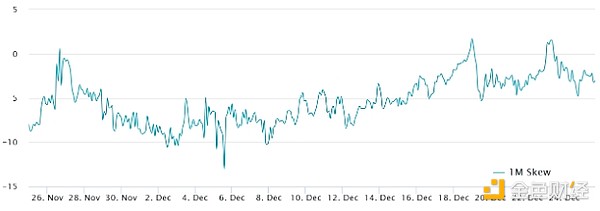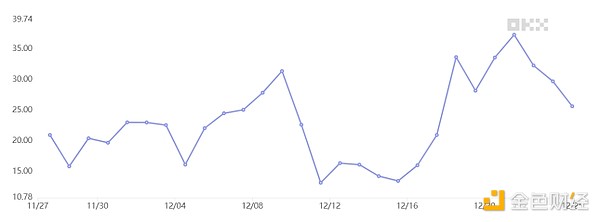Author: Marcel Pechman, CoinTelegraph; Translator: Tong Deng, Jinse Finance
Bitcoin has risen 6.5% since its low of $92,458 on December 23, but has failed to break through the $98,000 resistance level. After reaching a record high of $108,275 on December 17 last year, the market has seen a significant 14.5% correction, and traders have regained confidence.
Bitcoin derivatives maintain a neutral to bullish stance, indicating that the sharp price volatility has not significantly impacted market sentiment. This positioning supports the possibility of gold prices continuing to rise above $105,000.

Bitcoin 2-month futures annualized premium. Source: Laevitas.ch
The trading price of Bitcoin's monthly contract futures is 12% higher than the regular spot market. This indicates strong demand for leveraged long (buy) positions. Typically, a 5% to 10% premium is considered neutral, as sellers factor in the extended settlement period when pricing.

Bitcoin 1-month options 25% Delta skew (put options). Source: Laevitas.ch
Compared to equivalent call (buy) options, the trading price of Bitcoin put (sell) options has a 2% discount, consistent with the trend of the past two weeks. This indicator typically exceeds 6% when whales and market makers anticipate a potential correction, reflecting a premium on put options.
With the S&P 500 index erasing its monthly decline on December 24, the recent recovery in traditional financial markets has also pushed Bitcoin above $98,000. Additionally, the yield on the 10-year US Treasury bond has risen from 4.23% two weeks ago to 4.59%, indicating that investors are demanding higher returns for holding government debt.
The recent rise in US bond yields typically reflects expectations of higher inflation or government debt, which dilutes the value of currently held bonds. In contrast, when central banks are forced to stimulate the economy by injecting liquidity, scarce assets like stocks and Bitcoin tend to perform well.
Bitcoin Faces Stagnation Concerns Amid Economic Uncertainty
Bitcoin's upside potential remains limited due to investors' concerns about the risk of global economic stagnation. In this context, predicting the full impact on the stock market and real estate assets is challenging. Currently, Bitcoin's correlation with the S&P 500 index is relatively high at 64%.
The Federal Reserve has reduced its interest rate cut expectations, now indicating only two rate cuts by 2025, down from the previous expectation of four. This adjustment has lowered the short-term risk of declining corporate earnings and potential issues with real estate financing.
To assess market sentiment, analyzing Bitcoin's margin market is crucial. Unlike derivative contracts that require buyers and sellers, the margin market allows traders to borrow stablecoins to purchase spot Bitcoin or borrow Bitcoin to establish short positions, betting on price declines.

OKX's Bitcoin margin long-short ratio. Source: OKX
OKX's Bitcoin long-to-short margin ratio is currently 25x, favoring long (buy) positions. Historically, excessive confidence has driven this ratio above 40x, while levels below 5x are typically considered bearish.
Both Bitcoin derivatives and margin markets show a bullish trend, despite the record outflow of funds from the iShares Bitcoin Trust ETF (IBIT) by BlackRock on December 24. Additionally, the resilience shown when retesting the $92,458 level on December 23 has increased optimism that Bitcoin could reach $105,000 or even higher.








